Infant surfactant - Study guides, Class notes & Summaries
Looking for the best study guides, study notes and summaries about Infant surfactant? On this page you'll find 1578 study documents about Infant surfactant.
Page 2 out of 1.578 results
Sort by
![NURS 223: Exam 2 [Chapters 18, 35-40, 48-49] Well-Enlightened with 100% correct answers.](/docpics/5385457/664c714d1e824_5385457_121_171.jpeg)
-
NURS 223: Exam 2 [Chapters 18, 35-40, 48-49] Well-Enlightened with 100% correct answers.
- Exam (elaborations) • 67 pages • 2024
- Available in package deal
-
- $17.99
- + learn more
The nurse and nursing student are assessing a client experiencing shock. The nurse teaches the student that which of these findings reflects compensatory sympathetic stimulation in a shock state? a) decrease in the serum creatinine b) overgrowth of the glomerular basement membrane c) increase in thyroid hormone production d) decreased urine output correct answers d) decreased urine output During periods of strong sympathetic stimulation, such as shock, constriction of the afferent ar...
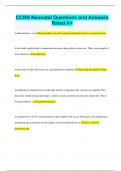
-
CCRN Neonatal Questions and Answers Rated A+
- Exam (elaborations) • 54 pages • 2024
-
Available in package deal
-
- $11.99
- + learn more
CCRN Neonatal Questions and Answers Rated A+ A deformation is a(n) abnormality caused by unusual mechanical forces on normal tissue. A low birth weight infant's temperature increases during skin-to-skin care. This is an example of heat transfer by conduction. At the onset of labor the release of catecholamines stimulates increased absorption of lung fluid. An edematous, bruised lesion on the right anterior scalp where the vacuum was applied. This lesion has clearly demarcated ...
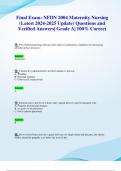
-
Final Exam: NFDN 2004 Maternity Nursing (Latest 2024-2025 Update) Questions and Verified Answers| Grade A| 100% Correct
- Exam (elaborations) • 24 pages • 2024
-
Available in package deal
-
- $10.99
- + learn more
Final Exam: NFDN 2004 Maternity Nursing (Latest Update) Questions and Verified Answers| Grade A| 100% Correct Q: The fetal/neonatal lung substance that improves pulmonary compliance by decreasing alveolar surface tension is: Answer: Surfactant Q: Vitamin K is administered to newborn infants to prevent: A. Bleeding B. Neonatal jaundice C. Gonococcal conjunctivitis Answer: A Q: Perineal pain in the first 4-6 hours after vaginal delivery may be managed with: A....
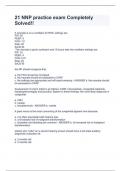
-
21 NNP practice exam Completely Solved!!
- Exam (elaborations) • 24 pages • 2024
-
Available in package deal
-
- $12.99
- + learn more
A neonate is on a ventilator for RDS. settings are PIP: 26 PEEP: 5 FiO2: 1.0 Rate: 20 SaO2 90 The neonate is given surfactant and 18 hours later the ventilator settings are PIP: 18 PEEP: 4 FiO2: 0.21 Rate: 20 SaO2 95 the NP should recognize that: a. the FiO2 should be increased b. the neonate should be extubated to CPAP c. the settings are appropriate and will assist weaning - ANSWER b. the neonate should be extubated to CPAP Assessment of a term infant is as follows: IUG...
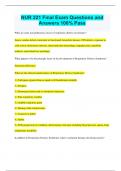
-
NUR 221 Final Exam Questions and Answers 100% Pass
- Exam (elaborations) • 29 pages • 2024
- Available in package deal
-
- $9.99
- + learn more
NUR 221 Final Exam Questions and Answers 100% Pass What are some non-pulmonary causes of respiratory distress in neonates? Sepsis, cardiac defects (structural or functional), hemolytic disease, CNS defects, exposure to cold, airway obstruction (atresia), intraventricular hemorrhage, hypoglycemia, metabolic acidosis, acute blood loss and drugs. What appears to be the principle factor in the development of Respiratory Distress Syndrome? Surfactant deficiency. What are the clinical mani...
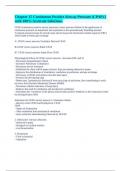
-
Chapter 15 Continuous Positive Airway Pressure (CPAP) || with 100% Accurate Solutions.
- Exam (elaborations) • 15 pages • 2024
-
Available in package deal
-
- $11.49
- + learn more
CPAP (continuous positive airway pressure) correct answers •Refers to the application of continuous pressure on inspiration and expiration in the spontaneously breathing neonate •Constant pressure keeps the alveoli open and increases the functional residual capacity (FRC) which leads to better gas exchange V- CPAP correct answers Ventilator Derived CPAP B-CPAP correct answers Buble CPAP IF- CPAP correct answers Infant Flow CPAP Physiological Effects of CPAP correct answers - Inc...
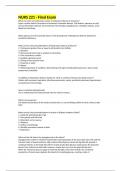
-
NURS 221 - Final Exam
- Exam (elaborations) • 14 pages • 2024
-
- $10.59
- + learn more
NURS 221 - Final Exam What are some non-pulmonary causes of respiratory distress in neonates? Sepsis, cardiac defects (structural or functional), hemolytic disease, CNS defects, exposure to cold, airway obstruction (atresia), intraventricular hemorrhage, hypoglycemia, metabolic acidosis, acute blood loss and drugs. What appears to be the principle factor in the development of Respiratory Distress Syndrome? Surfactant deficiency. What are the clinical manifestations of Respiratory Di...
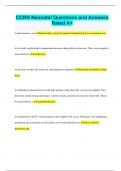
-
CCRN Neonatal Questions and Answers Rated A+
- Exam (elaborations) • 54 pages • 2024
-
- $12.49
- + learn more
A deformation is a(n) abnormality caused by unusual mechanical forces on normal tissue. A low birth weight infant's temperature increases during skin-to-skin care. This is an example of heat transfer by conduction. At the onset of labor the release of catecholamines stimulates increased absorption of lung fluid. An edematous, bruised lesion on the right anterior scalp where the vacuum was applied. This lesion has clearly demarcated edges, is firm to touch, and does not cross the suture li...
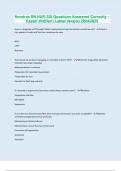
-
Hondros RN NUR 220 Questions Answered Correctly – Expert Verified | Latest Version 2024/2025
- Exam (elaborations) • 10 pages • 2024
- Available in package deal
-
- $10.49
- + learn more
How is a diagnosis of TTN made? What treatments/nursing interventions would we use? - Chest xray; appears streaky and fluid can sometimes be seen NICU CPAP Nutrition How would we go about managing an inevitable preterm birth? - Administer mag sulfate (prevents neonatal neurologic sequelae) Malpresentation is common Preparation for neonatal resuscitation Preparation for loss Steroids for fetal lung maturity If a neonate is exposed to Gonorrhea, which affects could be seen? - Blindness ...
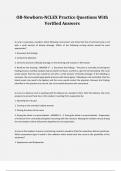
-
OB-Newborn-NCLEX Practice Questions With Verified Answers
- Exam (elaborations) • 14 pages • 2024
-
- $11.99
- + learn more
A nurse is assessing a newborn infant following circumcision and notes that the circumcised area is red with a small amount of bloody drainage. Which of the following nursing actions would be most appropriate? A newborn has small, whitish, pinpoint spots over the nose, which the nurse knows are caused by retained sebaceous secretions. When charting this observation, the nurse identifies it as: A nursing instructor asks a nursing student to describe the procedure for administering eryth...

How did he do that? By selling his study resources on Stuvia. Try it yourself! Discover all about earning on Stuvia


